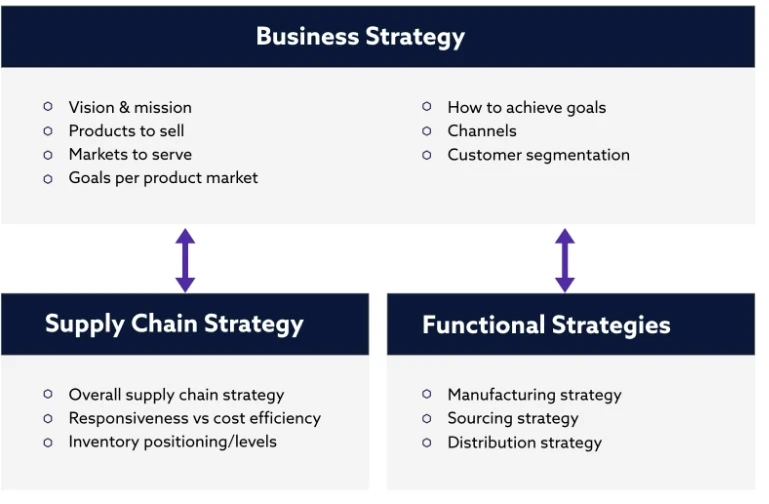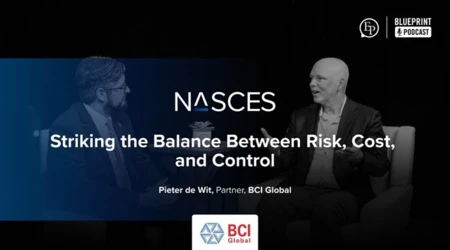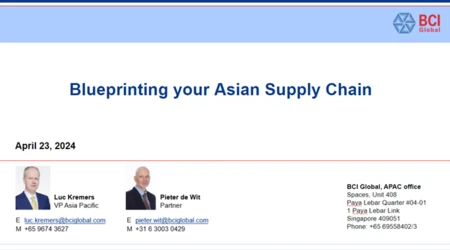Supply chain strategy
What supply chain do you have and should you have? Should the supply chain be efficient or agile or responsive or all of the above? How about resilience? Is one supply chain good enough or do you need to have several supply chains in place? These are key questions supply chain leaders need to ask themselves to set the right priorities and build the capabilities to manage today’s complex and highly volatile supply chains.
Supply chains need to be aligned to the overall business strategy. A company striving for Operational Excellence will need to have a different supply chain strategy in place than a company striving for Customer Intimacy or Product Leadership. However, defining your supply chain strategy based on clear customer requirements and fully aligned with all stakeholders in the organization is challenging. Many companies still operate without a clearly defined strategy. In some cases the exact number of distinct supply chains is not even defined. In other cases, the supply chain strategy has been defined in isolation and not jointly with the commercial team.
This means there is risk your operational teams at the functional level have mis-aligned functional strategies, with procurement going in one direction, and manufacturing in another. In these situations it means your teams struggle to make the right trade-offs and priorities when setting performance targets, configuring IT systems or do process improvements. Defining a clear supply chain strategy aligned with your business strategy is therefor key for success.
We believe that supply chain strategy should follow business strategy, based on clear customer requirements. Once defined, it drives the other functional strategies such as procurement, manufacturing, planning and distribution so that these are all aligned. The visual below highlights the dependency between the business strategy and the supply chain and functional strategies.
Key elements driving the business strategy include the overall vision, the geographical markets, the go-to-market strategy with clear service level requirements per product-market-channel combination. As companies are serving various customers with different products with varying characteristics, it is paramount to differentiate your supply chain per product-market-channel rather than having a single size fits all approach.

As a first step, companies should understand the level of demand uncertainty they face in their markets, and what are the customer requirements such as service level, response time, variety of products, product price and desired rate of innovation.
They then need to understand what supply chain capabilities are required in terms of ability to meet lead times, handle variety of products, build innovative products and manage supply uncertainty, basically the ability to offer a certain level of supply chain responsiveness. In general, responsiveness comes at a cost, so a careful trade-off is required. As a final step, an optimal strategy should be defined where the level of supply chain responsiveness offered should match with the level of demand uncertainty seen. The picture below illustrates the zone of strategic fit between the demand and responsiveness spectrum.





Our approach is based on a proven framework that identifies six distinct supply chain strategy archetypes:
- Efficient
- Fast
- Continuous replenishment
- Agile
- LeanAgile
- Flexible
The table below provides more detail on these six archetypes.

These archetypes fully describe all the supply chain process elements that are required to have a well-defined strategy. The BCI framework consists of 40 elements such as management focus, product related strategies (such as inventory strategy, level of customization), sourcing, production and fulfillment strategy elements. The benefit of using an archetype, is that all functional elements are internally consistent and aligned with each other. Your company can use the archetype that fits best to design your supply chain strategy. This is done through a 3-step approach:
1. Identify key characteristics of your business environment, customer requirements and the unique value proposal you are offering to the market.
2. Based on this, the framework will indicate which archetype supply chain strategy has the best fit. You can use this as the foundation to design your own supply chain strategy.
3. Once the overall supply chain strategy is determined, the framework will then give guidance on the configuration of your supply chain processes at functional level below (through these 40 elements). Of course you could deviate from this guidance, and in some cases that might be justified on some uniqueness in your business, but in most cases following the framework guidance yields the best results. In this way the BCI framework shows how overall supply chain strategy sets the direction for each function, to ensure alignment between each functional strategy and the overall supply chain strategy.
BCI framework for designing the right supply chain strategy


25 June 2025

29 May 2025

01 May 2025

03 February 2025

13 January 2025

17 September 2024

30 April 2024



12 March 2025

15 January 2025

11 December 2024

05 December 2024

15 December 2023

11 July 2023

03 April 2023

25 January 2023

19 December 2022

12 October 2022

13 June 2022

16 February 2022

01 September 2021

09 March 2022








